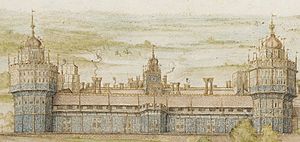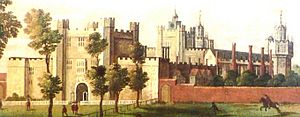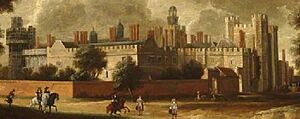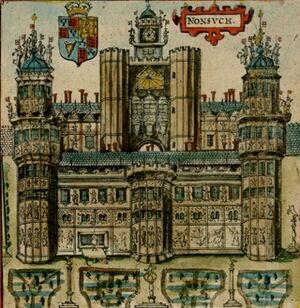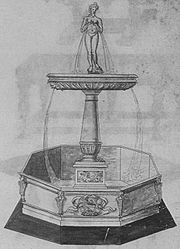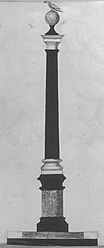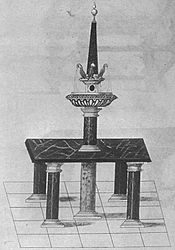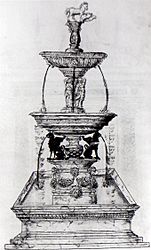Nonsuch Palace facts for kids
Nonsuch Palace was a grand royal palace built in the Tudor style. King Henry VIII started building it in Surrey, England, in 1538. The palace stood for about 145 years, from 1538 until it was pulled down in 1682–83. Today, its original location is part of Nonsuch Park, near Epsom and Ewell in Surrey and the London Borough of Sutton.
Contents
Why Was Nonsuch Palace Built?
Nonsuch Palace was one of King Henry VIII's most impressive building projects. He decided to build it on the site of a village called Cuddington, near Ewell. The church and village were removed to make space for the palace, and the villagers were paid for their homes.
Work on the palace began on April 22, 1538. This was an important time for Henry VIII, as it was six months after his son, Edward VI, was born. The name 'Nonsuch' appeared in the building records very quickly. It meant that there was no such palace anywhere else that could compare to its amazing beauty and size.
A Palace Like No Other
The main construction of Nonsuch Palace was mostly finished by 1541, but it took several more years to fully complete. The King's household took over huge areas of land around the palace. Because of this, some major roads had to be moved or changed to go around what became Nonsuch Great Park.
This palace was designed to show off the power and greatness of the Tudor dynasty. Henry VIII wanted it to be as grand as King Francis I's Château de Chambord in France. Unlike many of Henry's other palaces, Nonsuch was not an old building that was updated. He chose to build a brand new palace here because it was close to one of his favorite hunting areas.
However, the location wasn't perfect. There wasn't a good supply of water nearby for the palace's daily needs. Nonsuch Palace was very expensive to build, costing at least £24,000 (which would be around £104 million today). This high cost was due to its incredibly rich decorations. It is seen as a very important building because it brought new Renaissance designs to England.
Who Owned Nonsuch Palace?
When King Henry VIII died in 1547, the palace was still not fully finished. In 1556, Queen Mary I sold Nonsuch Palace to Henry FitzAlan, the 19th Earl of Arundel. He was the one who finally completed the palace.
In the 1590s, the palace became royal property again. After the English Civil War, the Nonsuch estate was taken by the government and given to a general named Thomas Pride. He owned it until he died in 1658.
The palace was given back to the royal family after the Restoration in 1660. It stayed royal property until 1670. Then, King Charles II gave it to his mistress, Barbara, Countess of Castlemaine. She had the palace completely pulled down around 1682–83. She sold off all the building materials to pay her gambling debts.
Some parts of the palace were used in other buildings. For example, some of the wooden panels from Nonsuch can still be seen today in the Great Hall at Loseley Park. There are no visible remains of the palace on its original site now. However, some pieces from the palace are kept at the British Museum. You can still see a slight rise in the land where the old Cuddington church used to be before it was demolished for the palace.
In 1585, an important agreement called the Treaty of Nonsuch was signed at the palace by Queen Elizabeth I and the Dutch Republic.
Discovering the Palace's Secrets
Only about three pictures of the palace from its time still exist. These pictures don't show much about how the palace was laid out or its exact details. However, archaeologists dug up the site in 1959–60. They found that the palace's design was quite simple. It had an inner and an outer courtyard, each with a strong gatehouse.
The outside of the palace and the outer courtyard were quite plain. But the inner courtyard was decorated with amazing stucco panels. These panels were molded in high relief, meaning the designs stood out from the surface. The northern side of the palace looked like a medieval fortress. But the southern side had fancy Renaissance decorations, with tall, octagonal towers at each end. It is thought that the famous music piece Spem in alium by Thomas Tallis might have been performed for the first time inside one of these towers.
During World War II, when trenches were dug, people reported finding pieces of pottery in the area. Later, these were found to be from the palace site. Also, an outline of the palace's layout could be seen from the air, which helped find its exact location. The excavation of Nonsuch in 1959 by Martin Biddle was a very important event for archaeology in the UK. It was one of the first times a site from after the medieval period was dug up. Over 75,000 visitors came to watch the work, and this excavation led to big changes in how archaeology is done for later historical periods.
The Palace Gardens
John Speed's map of Surrey from 1610 includes a small picture of the palace and some of its gardens. This picture shows some of the main decorations in the gardens. We also know about these decorations from detailed drawings in a book called the "Red Velvet Book," which was an inventory from 1590.
Images for kids
See also
 In Spanish: Palacio de Nonsuch para niños
In Spanish: Palacio de Nonsuch para niños


